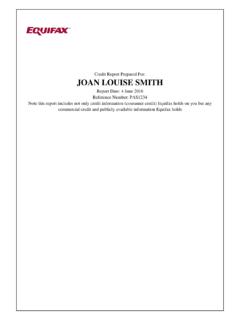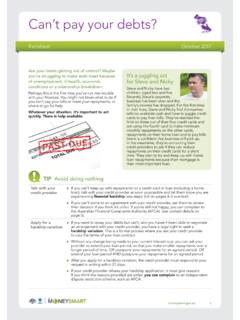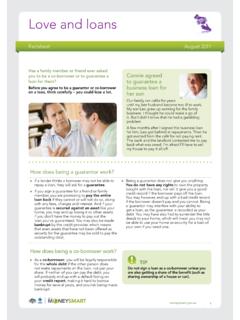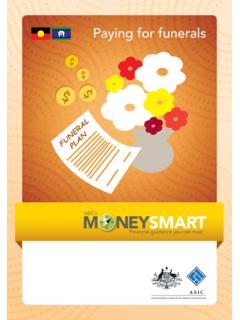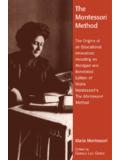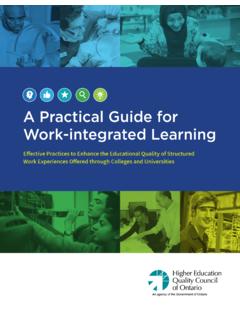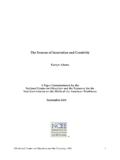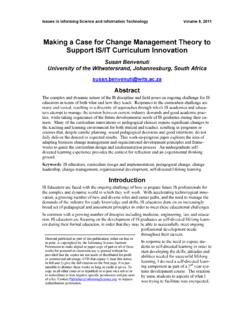Transcription of Innovation and enterprising behaviours - …
1 Innovation and enterprising behaviours A case study Note The concepts and processes in this case study are relevant to all year levels. In this instance activities are aligned with Year 6 Mathematics and English Australian Curriculum content descriptions. Copyright information Websites: , Creative Commons This case study is available under the Creative Commons licence (BY-NC-SA). Under this licence, the material is available for free use and adaption so that educators can use, adapt and re-publish material from the resource without seeking the permission of ASIC. Copyright notice This work is based on materials that constitute copyright of the Australian Securities and Investments Commission and is licensed under a Creative Commons Attribution Non-Commercial Share Alike Australia Licence.
2 For an explanation of what this licence allows you to do please refer to the Creative Commons website at You must include this statement on any adaption of the case study: This work is licensed under a Creative Commons Attribution Non-Commercial Share Alike Australia Licence (see: ). A Legal Notice applies to the use of these materials, see: Legal Notice: The material in this case study is made available for the purpose of providing access to general information about consumer and financial literacy education and is not professional advice. If you intend to rely on the material, you should obtain advice relevant to your particular circumstances to evaluate its accuracy, currency and completeness.
3 Some material may include or summarise views, standards or recommendations of third parties. ASIC does not endorse such material and its inclusion does not indicate that ASIC recommends any course of action. ASIC requests that if you re-publish this work that you notify ASIC by email We are interested in hearing how people are using and adapting the materials. CAL exemption This case study is exempt from collection by copyright agencies and is a free resource for educational institutions. Note All links were correct at the time of publication, however, due to the dynamic nature of the internet ASIC cannot guarantee they will remain correct.
4 2 Table of contents CASE STUDY 5 Overview 6 Introduction 6 Suburban profile 6 School profile 6 Background 6 Bulimba State School learning imperatives 2011 7 Bulimba State School vision 7 Australian Curriculum 7 Melbourne Declaration on Educational Goals for Young Australians (December 2008) 8 Middle schooling imperatives 8 Lit eracy and numeracy imperatives 8 National Consumer and Financial Literacy Framework 9 Enterprise unit of work implementation outline 9 Teaching and learning strategies 9 Reflection 12 Conclusion 13 APPENDICES 15 Appendix A: Product ideas 16 Appendix B: Partnership agreement 17 Appendix C: Running your business rules and information 20 Appendix D: Market research 21 What is a product?
5 22 What is market research? 22 What is a segment of the market? 22 What is a target market? 23 Conducting market research 24 Appendix E: The amazing secrets of print advertisements 26 Work out your Unique Selling Point (USP) 26 Keep it Short and Simple (KISS) 26 Always remember who your target market is! 26 Use the Attention, Interest, Desire, Action (AIDA) principle 27 Appendix F: Budgeted profit and loss statement 30 Appendix G: Technology task 33 Design a saleable product for a target market 33 Assessment rubric for technology task 34 3 Appendix H: Product development planning guide 36 Appendix I: General capabilities and enterprising skills and behaviours 37 Australian Curriculum general capabilities 37 National Consumer and Financial Literacy Framework ( ) 37 Appendix J: Links to the Australian Curriculum 38 Mathematics 38 English 41 Appendix K.
6 Links to the National Consumer and Financial Literacy Framework 44 4 Innovation and enterprising behaviours Case study 5 Innovation and enterprising behaviours : A case study Overview This case study describes the context and processes that a Bulimba State School teacher, Sonya Walker, undertook to implement an enterprise unit of work, culminating in a whole-school market day. This unit is informed by the: Australian Curriculum Year 6 English and Mathematics Australian Curriculum general capabilities National Consumer and Financial Literacy Framework student learnings National Consumer and Financial Literacy Framework enterprising behaviours .
7 This unit of work is designed to be taught in the last year of primary school. Introduction Suburban profile Bulimba State School is a large primary school of approximately 650 students, located in the inner-south-eastern Brisbane suburb of Bulimba, about 4 kilometres from the Brisbane CBD. The suburbs of Hawthorne, Balmoral and Bulimba feed in to the school. Twenty per cent of the population in the area is under 17 years of age. This demographic has impacted heavily on the development of the local state school. School profile Bulimba State School has developed rapidly over the past six years. Thirteen additional classrooms, a multi-purpose hall and an after-school-hours care facility have all been added to the school's infrastructure to cater for the growing demands of the school population.
8 A distinctive feature of Bulimba State School over the past 15 years has been the implementation of a curriculum embedded in sustainable practices. An environmental club, operational school farm, Stephanie Alexander Kitchen Garden Program and involvement in the Kids Teaching Kids Program (a school-based learning model and program of events that inspires young people to learn about and care for their environment) are examples of this sustainable focus. Bulimba State School has a stable, articulate school community who value quality education, as well as a dedicated and competent teaching staff. The school lives by its motto, 'Young minds grow in this garden', and focuses on developing tomorrow's citizens.
9 It was within this school culture that the enterprise unit of work that informed this case study was implemented. The concepts and principles of consumer and financial literacy education reflected in this enterprise unit of work can be applied in other Australian school contexts. Background In 2009, the Year 6 class teachers at Bulimba decided to plan for the inclusion of an enterprise unit of work into the Year 6 curriculum. Providing an engaging and relevant curriculum in the final year of primary school has been a feature of Bulimba State School's curriculum overview for many years. 6 Innovation and enterprising behaviours : A case study The overview for Year 6 consisted of the following units, which were integrated across English, Mathematics, Technology, Studies of Society and the Environment, The Arts, Physical Education and Health: Leadership unit and peer support training A sustainable practices unit ( sustainable energy) Celebrating the primary school journey and moving on to secondary school.
10 This included a personal development program that covered topics such as drugs and alcohol, relationships, financially responsible behaviour, spinal injury education, and healthy body and mind workshops. It concluded with a Year 6 musical to celebrate the primary school journey. It was felt that a practical, hands-on consumer and financial literacy unit, in the form of an enterprise unit of work delivered in Term 3, would complement the Year 6 program and would incorporate the following schooling imperatives: Bulimba State School learning imperatives 2011 Australian Curriculum Melbourne Declaration on Educational Goals for Young Australians Middle schooling imperatives Literacy and numeracy imperatives.



